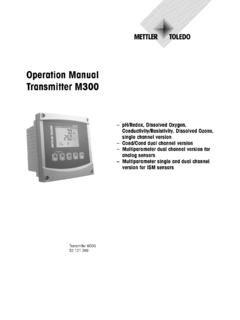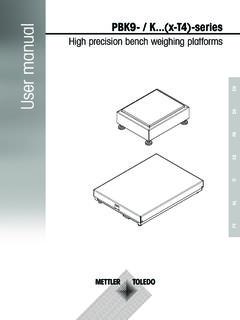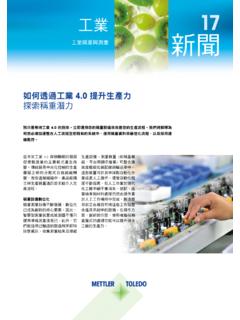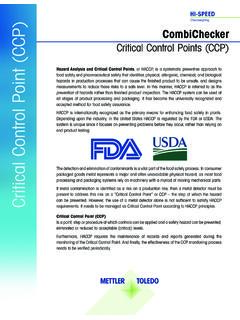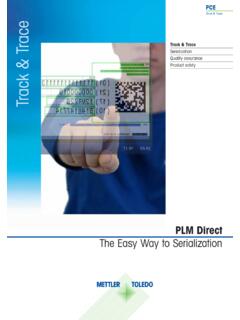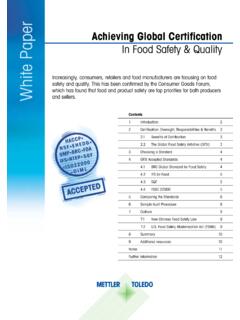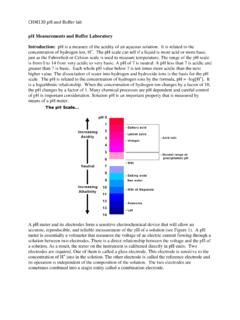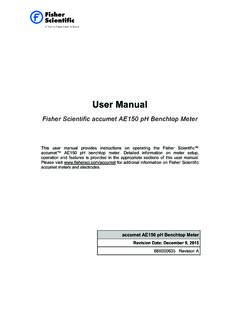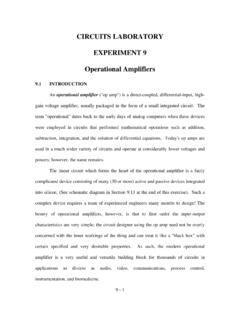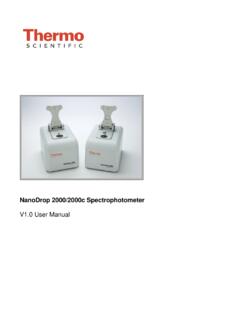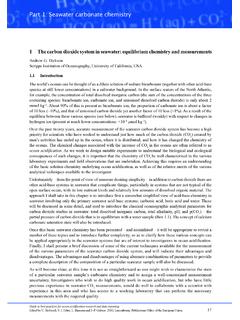Transcription of A GUIDE TO pH MEASUREMENT - Mettler Toledo
1 PH Booklet Master 25/5/99 10:57 pm Page 1. A GUIDE TO pH. MEASUREMENT . - the theory and practice of laboratory pH applications 1. pH Booklet Master 25/5/99 10:57 pm Page 2. introduction . This GUIDE to pH MEASUREMENT has been produced to accompany the latest development in laboratory pH technology. As well as an insight into the theoretical aspects of pH MEASUREMENT , sections covering applications and electrode troubleshooting have been included to make this a comprehensive review of the subject. 2. pH Booklet Master 25/5/99 10:57 pm Page 3. CONTENTS. Page Section 1 pH MEASUREMENT : Basic theory and practice 4. why are pH values measured? 4. how are pH values measured? 5. pH measuring system 8. temperature compensation 10. Section 2 laboratory measurements 13. applications of pH MEASUREMENT 15. Section 3 pH electrode systems 21. troubleshooting GUIDE 21. electrode storage 26. Section 4 Principles of electrochemistry 27. the theory of potentiometric titrations (Nernst Equation) 27.
2 Potential of the pH measuring system 29. correlation of concentration and activity 34. buffer solutions 36. calibration 40. relationship between pH value and temperature 40. phenomena in the case of special measuring solutions 44. glossary of terms relating to pH 47. 3. pH Booklet Master 25/5/99 10:57 pm Page 4. SECTION 1 pH MEASUREMENT : Basic theory and practice Why are pH values measured? The qualitative determination of the pH value of foodstuffs is probably the oldest analysis method in the world. All foodstuffs are tested with the taste organs. Thereby some are noticed to be acidic and some to be alkaline. With modern pH electrodes these taste sensations can be measured in exact figures (see fig. 1). acid neutral alkaline pH 0 1 2 3 4 5 6 7 8 9 10 11 12 13 pH 14. distilled water ( ). milk ( ). coffee ( ). beer ( ). orange juice ( ). fruit vinegar ( ). cola beverages ( ). Fig. 1: pH values of various foodstuffs Whether something is perceived as acidic or alkaline depends on the hydrogen ion (H+).
3 Concentration in the solution. The pH value is defined, by the Sorenson Equation, as the negative logarithm of the H+. concentration in a given solution (see table 1). In other words, at a high concentration, 1 mol/L = 100, pH = 0 (ACIDIC). at a low concentration, 10-14 mol/L, pH = 14 (ALKALINE). Hence, different substances are objectively compared with each other, where pH 0 is extremely acidic, pH 14 extremely alkaline, and pH 7 neutral. In the last few years the measuring of pH has gained in importance. In the control and regulation of chemical and biological processes, it has become indispensable to monitor the pH values. 4. pH Booklet Master 25/5/99 10:57 pm Page 5. Thanks to accurate pH control it is possible to: manufacture a product with defined attributes produce a product at low cost prevent damage to the environment, materials and humans satisfy legal regulations gain further knowledge in research range pH H+ concentration (mol/L) OH- concentration (mol/L).
4 0 1 0,00000000000001. 1 0,1 0,0000000000001. 2 0,01 0,000000000001. acid 3 0,001 0,00000000001. 4 0,0001 0,0000000001. 5 0,00001 0,000000001. 6 0,000001 0,00000001. neutral 7 0,0000001 0,0000001. 8 0,00000001 0,000001. 9 0,000000001 0,00001. 10 0,0000000001 0,0001. alkaline 11 0,00000000001 0,001. 12 0,000000000001 0,01. 13 0,0000000000001 0,1. 14 0,00000000000001 1. Table 1: pH scale How are pH values measured? In order to measure a pH value, a measuring electrode (pH electrode) and a reference electrode are needed. In many cases, a combination electrode, housing both measuring and reference elements, is used. 5. pH Booklet Master 25/5/99 10:57 pm Page 6. Glass electrodes A 'gel layer' develops on the pH-sensitive glass membrane when a pH glass electrode comes into contact with an aqueous measuring solution. Such a 'gel layer' arises also on the inside of the glass membrane which is in contact with a defined buffer solution (the inner buffer).
5 Membrane inner buffer lead-off element shield Fig. 2: Structure of a glass electrode The H+ ions either diffuse out of the gel layer, or into the gel layer, depending on the pH value of the measured solution. In the case of an alkaline solution the H+ ions diffuse out and a negative charge is established on the outer side of the gel layer. Since the glass electrode has an internal buffer with a constant pH value, the potential at the inner surface of the membrane is also constant during the MEASUREMENT . The total membrane potential is a result of the difference between the inner and outer charge. Eel = E0 S (pHa pHi). Eel = electrode potential E0 = zero potential S = slope (mV per pH unit). pHi = pH value of the internal buffer pHa = pH value of the measured solution glass membrane Positive internal buffer negative charge charge acidic solution alkaline solution H+. H +. Fig. 3: Schematic glass membrane ( - mm) representation of the function of the gel layer ca.
6 1000 A (10-4 mm) glass membrane 6. pH Booklet Master 25/5/99 10:57 pm Page 7. Reference electrodes The whole pH measuring circuit (fig. 4) consists of a measuring electrode (glass electrode; fig. 2) and a reference electrode (fig. 5), which are both immersed in the same solution. In order to obtain a definite pH value the reference electrode must have a defined stable potential which is independent of the measured solution. pH electrode reference electrode refill opening Fig. 4: Measuring circuit Every reference electrode consists of a reference element which is immersed in a defined electrolyte. This electrolyte must be in contact with the measured solution. This contact most commonly occurs through a porous ceramic junction. reference element Of the many reference systems, only the mercury/calomel and the silver/silver chloride systems, along with certain electrolyte modifications of them, have attained practical importance. Due to environmental considerations, however, the mercury junction electrode is rarely used today.
7 The potential of the reference electrode system is defined by the Fig. 5: reference electrolyte and the reference element ( silver/silver Structure of a reference chloride). Here it is important that the reference electrolyte has a electrode high ion concentration which results in a low electrical resistance. Ideally no reaction between the reference electrolyte and the measuring solution should occur over a wide temperature range. 7. pH Booklet Master 25/5/99 10:57 pm Page 8. Combination electrodes Since the combination electrode (fig. 6) is much easier to handle than the separate electrodes, the former is used almost exclusively today. In the combination electrode the glass electrode is concentrically surrounded by the reference electrolyte. refill opening Only when the different parts of the electrode are expected to have very different life expectancies is the use of separate electrodes recommended instead of a single combination reference electrode.
8 Electrolyte Three-in-one electrodes A recent innovation is the addition of a temperature sensor to lead off the pH combination electrode. element By housing the temperature sensor in the same body as the pH. and reference elements, temperature compensated readings can easily be made with a single probe. reference element Fig. 6: reference Structure of a junction combination inner buffer electrode membrane pH measuring system Successful pH MEASUREMENT can only be achieved by choosing the correct system to meet the demands of the sample under examination. As well as the correct apparatus, a supply of suitable reagents is vital. Consideration has to be given to: Type of pH meter: Specification, ease of operation Electrode(s): Is it suitable for this MEASUREMENT ? Is a pH electrode with built-in temperature sensor available? Temperature probe: Is temperature compensation required? Buffer solutions: Pure, correct value Reagents: Distilled water, electrolyte solutions, cleaning solutions Glassware: Clean, labelled Electrode holder: For housing electrode(s).
9 8. pH Booklet Master 25/5/99 10:57 pm Page 9. For optimal pH MEASUREMENT , the correct electrode must first be selected. The following criteria must be considered: Chemical composition, homogeneity, temperature, pH range, container size (length and width restrictions). The choice becomes particularly important for non-aqueous, low conductivity, protein-rich and viscous samples where general purpose glass electrodes are subject to various error sources. The response time and accuracy of an electrode is dependant upon a number of factors. Measurements at extreme pH values and temperatures, or low conductivity may take longer than those of aqueous solutions at room temperature with a neutral pH. The accuracy of pH readings will depend upon continued maintenance of the electrode, as well as experimental conditions such as temperature, clean or fresh buffer solutions and state of the sample. A pH electrode is characterised by its zero point and its slope, and a two point calibration is chosen for greater precision.
10 The response of a pH electrode is defined by the Nernst Equation E = E0 - RT pH. nF. Where E0 is a constant R is the gas constant F is the Faraday constant T is the temperature in Kelvin and n is the ionic charge When measuring hydrogen ions ( n = +1), the slope factor at 25 C (298 K) has a value of mV. This is termed the IDEAL SLOPE FACTOR. It follows that for a unit change in pH, an ideal measuring system will sense a mV change of mV. This MEASUREMENT of slope factor gives an indication of the performance of the electrode system. If electrodes are not cleaned after use, and are subject to long term neglect, then the accuracy of the system is lost. This loss of performance can be monitored by a steady decrease in the measured slope value of the system. When the slope value drops below 50 mV per decade (85 % slope efficiency) or drift at the zero point exceeds 30 mV, extensive reconditioning may return the electrode to the level of expected performance, but a change of electrode may be necessary to ensure accurate pH.

